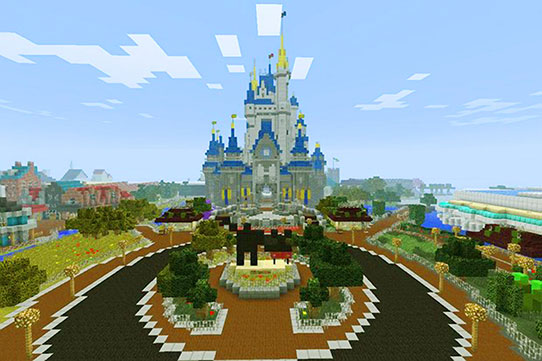I have written before about the SEND program. SEND trunks provide objects to classrooms throughout the state. Students can touch real things that represent and interpret the history they are learning about. Once in a while I get a chance to see how teachers and kids are using the trunks. Recently I overheard a group of fourth graders using the fur trade SEND trunk exclaim with excitement, “Hey, it’s just like Minecraft!” For those of you not familiar with the phenomenon of Minecraft, it is one of the most popular video games in the world having sold more than 60 million copies as of October 2014.

Minecraft Landscape
Minecraft is a world made up of colorful cubes that players use as resources to find, mine, and craft into other resources. Hit a block from a tree enough times and it turns into wood. Make enough wood and you can build a house. Two key features of Minecraft are that it is open ended and non-linear, and that it allows for social interaction with other players. The open-ended/non-linear format can be seen in a variety of other video games including Farmville and the Sims. Rather than having to achieve something specific to get to the next level, Minecraft players simply have to stay alive and keep crafting new things. The concept gives players an incredible amount of freedom and independence, and allows for a great deal of creativity in a game. The social aspect of the game allows players to interact with each other, create communities, and trade things. One player might be the best person among a group of friends at providing food, while someone else excels at building shelter. Playing together produces a stronger community.

Disneyworld rendered in Minecraft
While much has been written about the evils and dangers of video games, there is a lot of new research focused on how games like Minecraft encourage learning and social interaction among players. The multi-player mode allows kids to form communities and play together in one world. This gives socially awkward kids an opportunity to socialize and make friends. It also fosters an interest in STEM (science, technology, engineering, and math). One company, MinecraftEdu, makes affordable versions of the game available to schools. Websites like Minecraft Teacher (minecraftteacher.tumblr.com) and Teaching with MinecraftEdu (services.minecraftedu.com/wiki/Teaching_with_MinecraftEdu) help teachers develop lesson plans based on the game. For example, teachers have created lesson plans using Minecraft to teach math and scale by constructing buildings in the game. Others teachers have taught architecture, geography, and history by having students build entire cities in the game.

The Eiffel Tower rendered in Minecraft
What does all of this mean for our fur trade trunk? Education department staff are exploring ways in which we can take advantage of the open ended and social gaming aspects of Minecraft to teach about the fur trade. Maybe our game could have students acquire furs faster for every ten Objibwe words they learn. This doesn’t mean we have to sacrifice education for entertainment, but rather we can enhance education by making it engaging.

